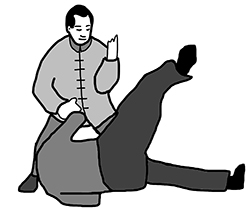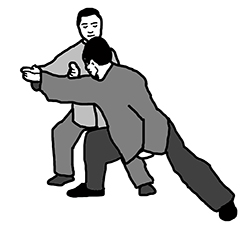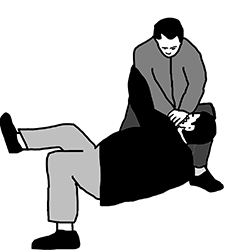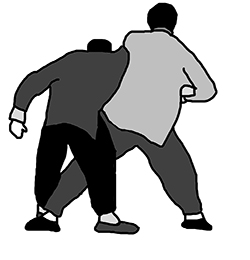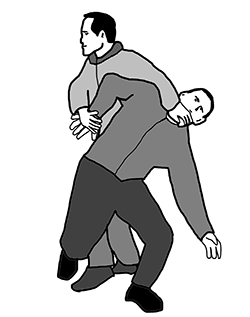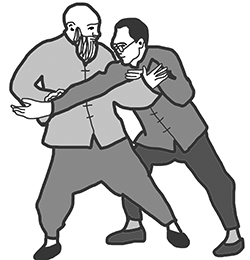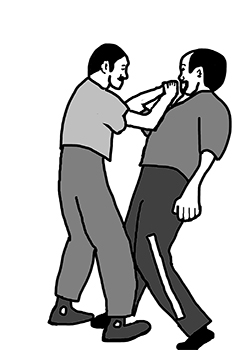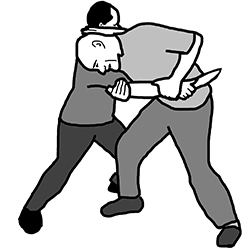
Martial Applications
Being victorious in an altercation is a necessity. Taijiquan trains your ability to stay balanced even during a violent encounter.
Fighting for What’s Right
The martial arts were created to defend life and limb. Taijiquan training offers a safe way to learn how to prove victorious if engaged in a fight. When discussing its martial side, Taijiquan is done with deadly seriousness. Mortal combat is not sparring or sport fighting.
Without the martial components of Taijiquan, you will never reach its full depths. Taijiquan was born in rural China at a time its citizens faced threats from robbers, hoodlums, and soldiers. Times weren’t particularly safe, and people were on their own to protect themselves and their villages. Being able to defend yourself is a basic right and obligation.
Though physical fighting may be rare in your experience, knowing how to stand up for yourself in the face of threat and adversity is a fundamental right, which bequeaths you with empowering virtues. Taijiquan skills can help you defend yourself and protect the things you value most. The prudent thing is to do what you can in order to protect the sanctity of your life, your health, your liberty, your family, your possessions, your honor, and your reputation.
Violence Comes on Suddenly and Unexpectedly
Fights happen in different contexts. There are hoodlums, bullies, and terrorists willing to attack. Their gambit is to move against you when you are living your life without the expectation of violence, when you are otherwise engaged and at your most vulnerable. Those wishing to harm you will try to take you unawares. And unless you are in a profession that requires a constant readiness such as law enforcement, military, or security; or if you live in, travel through, or arrive at a place where violent activity is the norm, chances are violence in your life is a rare occurrence. But, however rare it may be, when you encounter violence, you will be forced to face it as you are in that moment.
Most people, most of the time, do not encounter physical violence. If you are attacked, it’s unlikely you will have time to prepare. Your reaction will be immediate. A key concept to dealing with any unpredictable encounter is to be responsive as opposed to being reactive. Without training you are likely to be thrown off-balance and react by fighting, fleeing, or freezing. However, if you can maintain your equilibrium, you bring a fuller awareness to the moment and may be able to respond by remaining present, adaptable, and in control.
Taijiquan trains you to have the ability to use skillful power as opposed to relying upon the force of raw physical strength, which invariably you should assume that you are out-gunned. Taijiquan empowers you to face a situation as it is, giving you the best opportunity to end the encounter in your favor.
Handling an Aggressor
The martial arts were invented to create a great equalizer for those smaller and weaker than those posing a threat to them. In almost every case an attacker feels confident of his superiority. Intimidation is very often the tactic used by a person attempting to force you into surrounding your possessions or body. Threats of doing you harm can often lead to your capitulation. Surrendering can open the door to an accelerating series of disastrous steps toward a loss of life, limb, property, and personal sanctity.
Standing up to a bully will often cause the bully to back down. Bullies tend to be fearful and insecure. When intimidation fails them, they often cease their pressure tactics. However, many times the bully will escalate the attempt at intimidation—even accelerating into pushing and hitting. Taijiquan trains your body the ability to be responsive without having to rely upon a specific counter-technique. Rather. Taijiquan relies on the methods of engagement and responsiveness.
Fighting as an Necessity
Avoiding the fight is nearly always the best option. Even if you prove victorious in a violent encounter, you are likely to have received some sort of injury. And if you maim or kill your adversary, you face the consequences of your actions. At minimum your conscience will be marked by the event’s traumatic nature. In addition, you may need to heal from serious injury, and you may face legal action, which can make the event linger for years.
If you are able to make a defensive stand, your Taijiquan skills—at whatever level they are—will be there to draw upon. If you have trained in push hands you will be familiar with being in contact with an opponent as the situation progresses. If you are familiar with how to use your skills, you may be able to thwart your attacker.
Fighting as an Agreement
Other than a renegade attack, most fights don't escalate to physical violence. Instead they tend to be verbal in nature. Typically, those fights are with people you care most about: your families, friends and colleagues. In these situations, the violence is emotional. The attacks can hurt quite deeply and have lasting impact. Regrettable words are exchanged. Psychological damage can result from these sorts of fights leaving you or others with residual trauma and loss of self-esteem.
If it seems a paradox that most fights include an agreement, consider that according to Taiji theory, two opposites always contain a bit of the other. When yin reaches its maximum it transforms into yang. When a disagreement escalates and two people commence to fight, they have both chosen to enter the altercation. Their fight requires willing participation.
Tempers flare; voices shout; angry words are hurled. Escalating emotions increase physical tension. Tension rising is a consequence of Qi rising. Rising Qi disrupts the center of balance. Releasing tension, dropping Qi, and maintaining center are cornerstones of Taijiquan practice. Your ability to maintain a calm and centered presence empowers you to be able to listen and respond appropriately. Taijiquan gives back your own freedom to choose how to respond. Even in difficult situations, the best use of Taiji's self-defense capability is to be able to transmute a situation of conflict into one of cooperation.
The Stages of a Fight
To train the skills needed to be victorious in a fight, Taijiquan considers two phases of an altercation. The first phase is the moment before an attack reaches your body. The second phase takes place after the initial contact is made. The Yin response to an attack is to receive it. Receiving appropriately means maintaining your center, and equilibrium. It incorporates an aspect of Taijiquan’s softness. Compression, absorption, and condensing describe the quality of receptivity. You avoid resisting or running away from the attack. Upon intercepting the attack, you stick like tape to your attacker. Sticking is a primary way Taijiquan nullifies the attacker’s power.
Sticking without resisting often changes the dynamics of the encounter right from the outset. The average, untrained attacker uses brute force expecting to overwhelm a victim. Softness allows you to meld with the incoming strike and join with it. Once the connection is made, the initial attack is nullified. Now you can redirect your attacker and progress into the second stage of the fight.
Once the connection is made, the encounter moves into the second stage of the fight. Each of the postures in Taijiquan can applied to any number of different situations. Taijiquan combines eight postural energies for the upper body (Bagua) with five directions for relocating the body (Five Elements). The eight energies for the upper body are expanding (upward or Peng), absorbing (rollback or Lu), crushing (pushing or An), expelling (pressing or Ji), dividing (split or Lieh), snatching (plucking or Cai), striking (elbow or Jou), and smashing (shoulder or Kao). In terms of moving in space the directions are forward, backward, right, left, or remaining in place.
Defending Against an Armed Assailant
Weapons dramatically change the nature of an altercation. Knife or club wielding assailants need to get in close proximity to be able to use their weapon against you. Blades will cut even with light contact. Highly trained fighters acknowledge that even with great skills, the likelihood of being cut in a fight with a knife is high. Staying out of range of the weapon is the best option for not getting injured. It may not be possible to maintain a safe distance from the attacker. Every situation is unique. If your attacker is demanding money, the wise thing to do is give it away. Money is replaceable. You are not. If your life is is on the line, you may accept that you are already dead. Therefore, you have no reason holding back your ferocity. Watch your attacker, not the weapon. Disable him. Incapacitate him. Kill him, if necessary. Deal with the consequences of those choices after the fight has ended.
